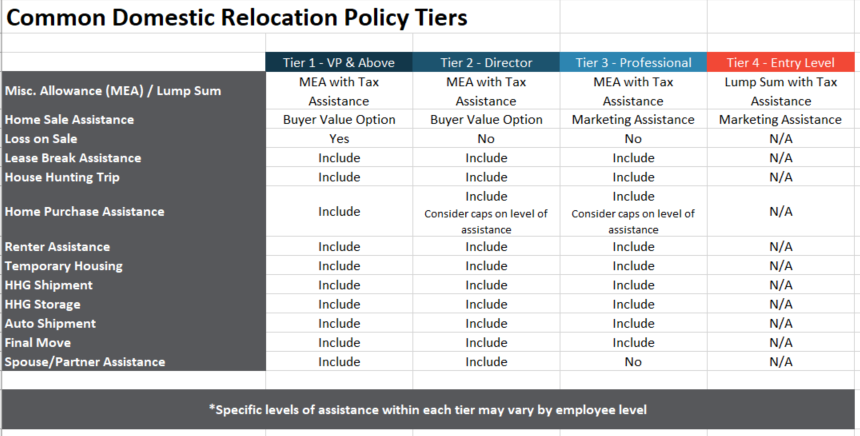As the competition for top talent intensifies and employee expectations evolve, relocation benefits are no longer just a perk—they’re a critical component of employer value propositions. For companies planning for 2026, here are key trends and strategic considerations to ensure your relocation policies are attractive, cost-effective, and aligned with both employee needs and business goals.
1. Flexibility & Customization
One-size-fits-all relocation packages are increasingly outdated. Different roles, employee life stages, family situations, and locations necessitate varying levels of support. Some employees will prefer full reimbursement of expenses, while others may prefer a lump sum to manage their own move. Tailored packages can include options like:
- Spousal job search assistance
- Schooling or childcare assistance
- Temporary housing or extended lodging
- Phased or partial relocation (e.g., remote-first periods or hybrid commuting)
Flexibility enables companies to meet diverse needs, enhance satisfaction, and mitigate relocation declines.
2. Technology & Digital Support
Relocation logistics are complex, especially for global or long-distance moves. In 2026, technology will play a bigger role in simplifying and automating these processes:
- Digital platforms or dashboards to track expenses, real-time status, and compliance.
- Virtual tools, such as AR/VR for home tours, reduce travel and enable employees to begin settling in remotely.
- AI for cost projections, moving vendor selection, and customizing policy options based on individual profiles.
2. Technology & Digital Support
With inflation, rising housing costs, and tighter budgets, companies must strike a balance between generosity and fiscal responsibility. Key levers include:
- Lump-sum payments vs complete reimbursements. Many firms are shifting toward managed lump sums (where the employee gets a sum but works through a vetted relocation provider or uses approved services) to reduce the risk of misuse or under-support.
- Clawback or repayment provisions: to protect the company if the employee leaves soon after relocating.
- Adjusting for the cost of living and housing market changes in destination cities. Ensuring that the total compensation package reflects what it’s really going to cost employees to live in the new place
4. Employee & Family Well-Being
With inflation, rising housing costs, and tighter budgets, companies must strike a balance between generosity and fiscal responsibility. Key levers include:
- Lump-sum payments vs complete reimbursements. Many firms are shifting toward managed lump sums (where the employee gets a sum but works through a vetted relocation provider or uses approved services) to reduce the risk of misuse or under-support.
- Clawback or repayment provisions: to protect the company if the employee leaves soon after relocating.
- Adjusting for the cost of living and housing market changes in destination cities. Ensuring that the total compensation package reflects what it’s really going to cost employees to live in the new place
5. Sustainability & Corporate Responsibility
The environmental impact of relocation is becoming an area of scrutiny. Forward-thinking companies in 2026 will factor in sustainability in policy design:
- Using green moving practices (eco-friendly packing materials, lower emissions transport, minimizing waste).
- Encouraging sustainable housing options and communities with good public transit, as well as energy-efficient buildings.
- Aligning relocation policies with broader ESG goals can enhance employer branding and help meet stakeholder expectations.
6. Transparency & Clear Communication
Ambiguity kills trust. If relocation policies are confusing or hidden, employees may decline offers or leave prematurely. To maximize value:
- Clearly define what is included: what counts as a relocation-eligible distance, what expenses are covered, and what timelines are expected.
- Be upfront about things like tax implications, gross-ups, repayment obligations or clawbacks.
- Provide clear procedural steps and contacts, including who to contact for specific tasks, how to obtain moving quotes, and the process for managing approvals.
7. Monitoring & Policy Review
What works today may not be sufficient in 2026. Companies should build in mechanisms to monitor and evolve their relocation programs:
- Solicit feedback from employees who have relocated: what worked, what didn’t.
- Track metrics: declines, retention after relocation, cost vs budget, impact on productivity, time to settle in.
- Stay abreast of legal, immigration, tax, housing, and real estate regulation changes, especially for cross-border relocations or remote work policies.
Work with GMS for Relocation Benefits
Relocation benefits in 2026 will be judged not just by the dollars spent, but by how well they address flexibility, empathy, efficiency, and responsibility. For companies that get it right, these programs can be powerful tools to attract talent, cement loyalty, and project a modern, human-centred employer brand.
At GMS Mobility, we help you design and optimize relocation benefit programs that strike a balance between employee expectations and business strategy. If you’d like to explore how your relocation benefits stack up or how you can evolve them for the future, we’re here to assist.
We're Here to Help! Request a Courtesy Consultation
Are you ready to talk to a Mobility Pro? Learn how GMS can optimize your mobility program, enhance your policies to meet today’s unique challenges, receive an in-depth industry benchmark, or simply ask us a question. Your Mobility Pro will be in touch within 1 business day for a no-pressure, courtesy consultation.





